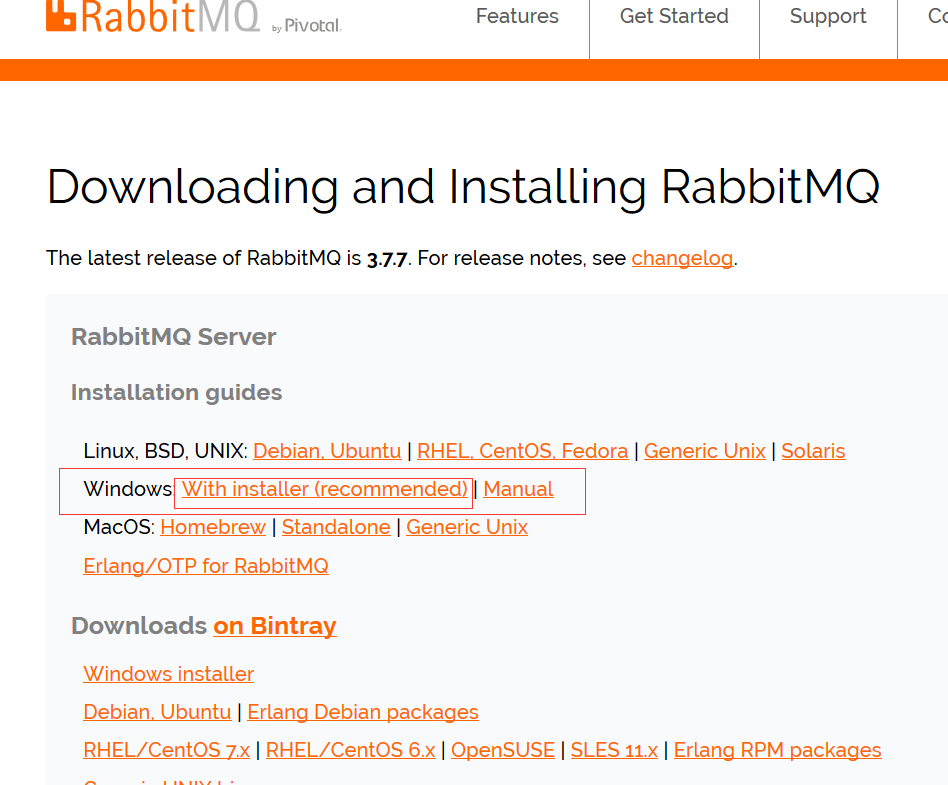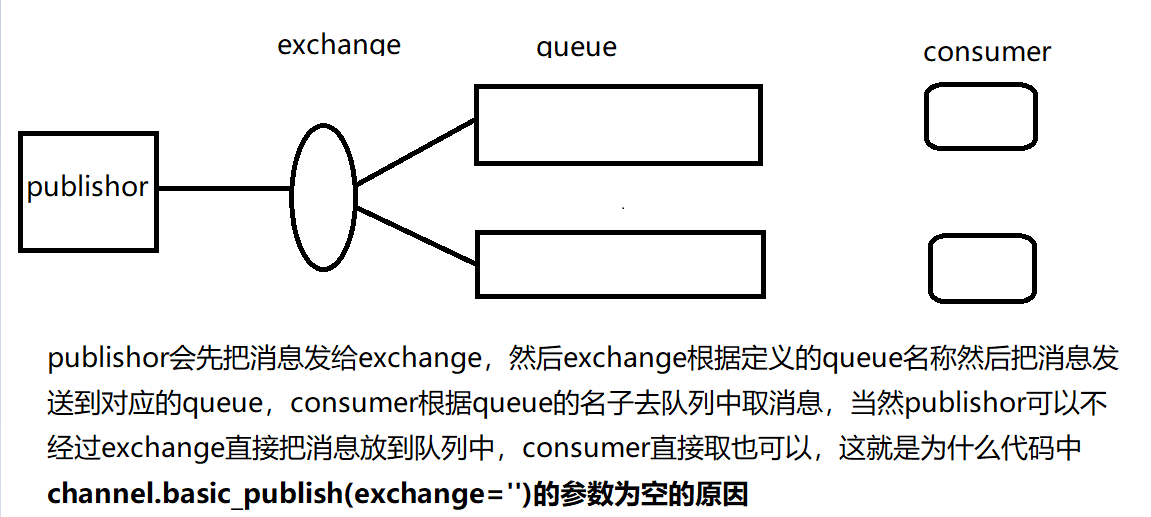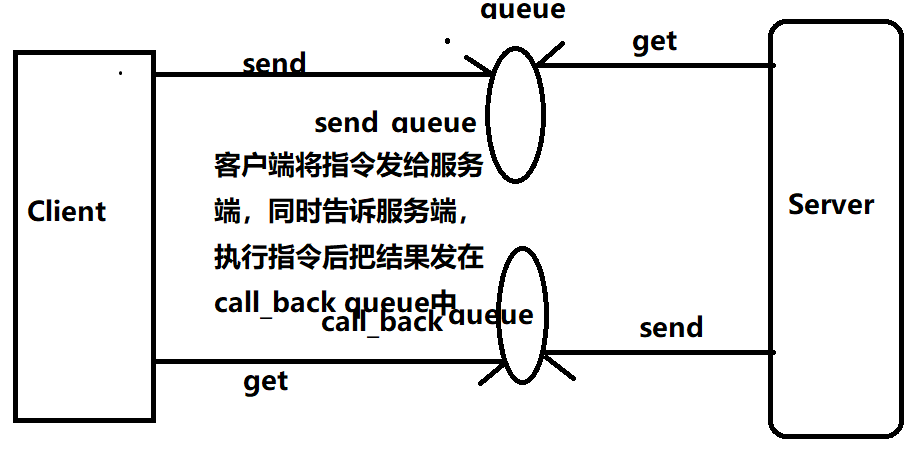0、讲述rabbit中各部分的含义及作用
https://www.jb51.net/article/75647.htm
1、rabbitMQ的安装
1)在安装rabbitmq之前需要先安装erlang,下载地址如下:
http://www.erlang.org/downloads根据系统选择,安装按提示一直下一步就OK,安装完后,再安装rabbitmq

2、rabbitmq的下载地址:http://www.rabbitmq.com/download.html

3、rabbitmq队列
假设现在需要从武汉到北京去见一个网友,哈哈哈,先的打电话约下,然后确定路线和交通工具吧,这就是下边这段代码的实际模型
import pika import random connection = pika.BlockingConnection(pika.ConnectionParameters('localhost')) #先打电话约下,看能否找到人 channel = connection.channel() #确定路线 channel.queue_declare(queue='task_queue', durable=True) #确定交通工具,而且交通工具的名称叫‘task_queue',durable = True表示就是你到了北京以后交通工具依然存在 number = random.randint(1, 1000) message = 'hello world:{num}'.format(num = number) channel.basic_publish(exchange='', #交换机,此时没有交换机参与,所以参数为空, routing_key='task_queue', #交通工具的名称 body=message, #要发送给的内容 properties=pika.BasicProperties( delivery_mode=2,) #表示不管路通不通,你携带的消息都不会因为外界情况而消失 ) print(" [x] Sent %r" % (message,)) connection.close()
import pika import time hostname = 'localhost' parameters = pika.ConnectionParameters(hostname) connection = pika.BlockingConnection(parameters) channel = connection.channel() channel.queue_declare(queue='task_queue', durable=True) def callback(ch, method, properties, body): print(" [x] Received %r" % (body,)) # time.sleep(5) print(" [x] Done") ch.basic_ack(delivery_tag=method.delivery_tag) #回调函数中需要给发布者发送的消息 channel.basic_qos(prefetch_count=1) channel.basic_consume(callback, queue='task_queue', no_ack=False) #no_ack=False当消费者接到消息后,需要调用回掉函数告诉发布者,消息的接受情况 print(' [*] Waiting for messages. To exit press CTRL+C') channel.start_consuming()

下边的代码是通过交换机来实现消息的发送的,具体如下:
import pika connection = pika.BlockingConnection(pika.ConnectionParameters( host='localhost')) channel = connection.channel() channel.exchange_declare(exchange='logs', #交换机的名称为logs exchange_type='fanout') message = "info: Hello World!" channel.basic_publish(exchange='logs', routing_key='', body=message) print(" [x] Sent %r" % message) connection.close()
import pika connection = pika.BlockingConnection(pika.ConnectionParameters(host='localhost')) channel = connection.channel() channel.exchange_declare(exchange='logs', #声明交换机的名称以及交换机发送消息的模式,这的名称要和publishor的交换机的名称相同,相当于publishor和consumor同时向exchange寻找,
#否则publishor和consumor相互找不到,会迷路!! exchange_type='fanout') #这不同的版本有可能会出错,有的说的是可以写为type = 'fanout',在我的电脑上运行会出错,
#改为exchange_type = 'fanout'仍然会出错,后来运行cmd->service.msc->找到rabbitmq关闭后再启动就OK了,
#至于为啥,如果你找到了,跟我说一声,先谢谢啦 result = channel.queue_declare(exclusive=True) # 不指定queue名字,rabbit会随机分配一个名字,exclusive=True会在使用此queue的消费者断开后,自动将queue删除 queue_name = result.method.queue #得到队列的名字 channel.queue_bind(exchange='logs', queue=queue_name) #将交换机和队列的名字绑定,也就是说exchange = ‘logs'的交换机只能公国queue = queue_name来发送消息 print(' [*] Waiting for logs. To exit press CTRL+C') def callback(ch, method, properties, body): print(" [x] %r" % body) channel.basic_consume(callback, queue=queue_name, no_ack=True) channel.start_consuming()
4、rabbitmq有选择的接受消息,模型如下

更过相关内容详见:http://www.cnblogs.com/alex3714/articles/5248247.html
5、client发送给指令,server根据指令运行完毕后再将结果返回给client
import pika import uuid class FibonacciRpcClient(object): def __init__(self): self.connection = pika.BlockingConnection(pika.ConnectionParameters( host='localhost')) self.channel = self.connection.channel() result = self.channel.queue_declare(exclusive=True) self.callback_queue = result.method.queue self.channel.basic_consume(self.on_response, #类中定义的方法__init__()是为了建立链接,同时定义一个callback_queue,再basic_publish中传递给server端,用于存放运行的结果 no_ack=True, queue=self.callback_queue) #这里的basic_consume只是声明,如果要取消息应该取callback__queue中取 def on_response(self, ch, method, props, body): if self.corr_id == props.correlation_id: #确定发的指令和收到的结果是相互对应的 self.response = body def call(self, n): self.response = None self.corr_id = str(uuid.uuid4()) self.channel.basic_publish(exchange='', routing_key='rpc_queue', properties=pika.BasicProperties( reply_to=self.callback_queue, correlation_id=self.corr_id,), body=str(n)) while self.response is None: self.connection.process_data_events() #去队列中取数据,不停的循环,非阻塞版的start_consuming(),去调用basic_consume() return int(self.response) fibonacci_rpc = FibonacciRpcClient() print(" [x] Requesting fib(30)") response = fibonacci_rpc.call(30) print(" [.] Got %r" % response)
import pika import time connection = pika.BlockingConnection(pika.ConnectionParameters( host='localhost')) channel = connection.channel() channel.queue_declare(queue='rpc_queue') def fib(n): if n == 0: return 0 elif n == 1: return 1 else: return fib(n - 1) + fib(n - 2) def on_request(ch, method, props, body): #method存放的是bsic_consume中读取数据routing_key,props中存放的是从basic_consume中读取的protperties的数据,body存放的是从发送过来的消息。 n = int(body) print(" [.] fib(%s)" % n) response = fib(n) ch.basic_publish(exchange='', routing_key=props.reply_to, properties=pika.BasicProperties(correlation_id= props.correlation_id), body=str(response)) ch.basic_ack(delivery_tag=method.delivery_tag) channel.basic_qos(prefetch_count=1) channel.basic_consume(on_request, queue='rpc_queue') print(" [x] Awaiting RPC requests") channel.start_consuming()
